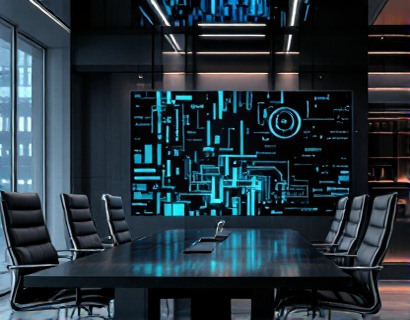Elevate Your Architecture Firm's Management with Advanced Software Solutions
In the dynamic and competitive world of architecture, managing a firm efficiently is crucial for success. Advanced software solutions have emerged to streamline internal processes and enhance user experience, allowing architects to concentrate on their creative vision while optimizing project management, resource allocation, and client interactions. These tools not only improve productivity and collaboration but also provide a competitive edge in a market where efficiency and innovation are key differentiators.
Streamlining Internal Processes
One of the primary benefits of implementing advanced software solutions in an architecture firm is the streamlining of internal processes. Traditional methods often involve manual tasks, paper-based workflows, and disjointed communication, which can lead to errors and inefficiencies. Advanced software automates routine tasks such as document management, time tracking, and invoicing, reducing the likelihood of human error and freeing up valuable time for more critical tasks.
Project management tools integrated within these platforms allow for real-time tracking of project progress, from initial conception to completion. This visibility ensures that all team members are aligned and informed, reducing the risk of delays and miscommunications. Task assignments, deadlines, and milestones can be set and monitored, providing a clear overview of the project lifecycle.
Enhancing User Experience
The user experience within an architecture firm is paramount, both for internal teams and clients. Advanced software solutions are designed with intuitive interfaces that simplify complex tasks, making them accessible to users of all skill levels. For architects, this means a more user-friendly environment that supports their creative process without unnecessary distractions.
Client portals integrated into these platforms offer a seamless and secure way for clients to access project updates, view designs, and provide feedback. This direct line of communication enhances client satisfaction and trust, as they feel more involved and informed throughout the project journey. The ability to manage client interactions efficiently also allows architects to focus on delivering high-quality designs.
Optimizing Resource Allocation
Effective resource allocation is critical for the success of any architecture firm. Advanced software solutions provide robust tools for managing resources, ensuring that projects are staffed with the right personnel and materials are available when needed. These tools can analyze project requirements and automatically suggest optimal resource assignments based on availability, skills, and past performance.
Budget management is another area where these solutions excel. By providing detailed financial tracking and forecasting capabilities, firms can better manage their budgets, identify potential cost overruns, and make informed decisions to keep projects on track. This level of control not only helps in maintaining profitability but also in delivering projects within the agreed-upon budget constraints.
Improving Collaboration
Collaboration is at the heart of architecture, and advanced software solutions facilitate seamless collaboration among team members, stakeholders, and clients. Cloud-based platforms enable real-time collaboration on design files, allowing multiple users to work on the same project simultaneously without the risk of version control issues.
Integration with communication tools such as chat, video conferencing, and file sharing ensures that all team members are connected and can collaborate effectively, regardless of their physical location. This is particularly beneficial for firms with remote workers or multiple office locations, as it fosters a cohesive and productive work environment.
Enhancing Productivity
The ultimate goal of implementing advanced software solutions in an architecture firm is to enhance overall productivity. By automating repetitive tasks, providing real-time data, and facilitating collaboration, these tools enable architects and their teams to work more efficiently. Time saved on administrative tasks translates directly into more time for creative work, leading to higher quality designs and faster project completion.
Productivity gains are not just quantitative; they also contribute to a better work-life balance for team members. With tasks managed more efficiently, there is less stress and burnout, leading to a more motivated and engaged workforce. This, in turn, can result in higher job satisfaction and lower turnover rates, which are critical for the long-term success of any firm.
Case Studies and Success Stories
Several architecture firms have already experienced significant improvements by adopting advanced software solutions. For instance, a mid-sized firm in New York reported a 30% reduction in project delivery time after implementing a comprehensive project management platform. The firm's managers attributed this success to better resource allocation and real-time visibility into project statuses.
Another example is a large international firm that utilized a cloud-based design collaboration tool. This tool enabled their global teams to work together seamlessly, reducing the time to resolve design issues by 40%. The firm noted a marked improvement in client satisfaction due to the enhanced transparency and responsiveness in project management.
Choosing the Right Software Solution
With the numerous options available in the market, selecting the right software solution for your architecture firm is crucial. It's important to consider the specific needs and size of your firm, as well as the integration capabilities with existing systems. A thorough evaluation of features, user support, and scalability should be conducted before making a decision.
It's also beneficial to seek recommendations from peers and industry experts, and to request demos or trials to assess the software's usability and effectiveness. A reputable vendor should provide comprehensive training and ongoing support to ensure a smooth transition and continuous improvement in your firm's operations.
Future Trends in Architecture Software
The landscape of architecture software is continually evolving, driven by advancements in technology such as artificial intelligence, machine learning, and the Internet of Things (IoT). These technologies are poised to further enhance the capabilities of software solutions, offering even more sophisticated tools for project optimization, predictive analytics, and smart building design.
For instance, AI-driven design tools can analyze vast amounts of data to suggest optimal design solutions, taking into account factors such as sustainability, cost, and functionality. IoT integration can enable smart buildings to communicate with design software, providing real-time data on energy usage, occupancy, and environmental conditions to inform design decisions.
Embracing these emerging trends can position your firm at the forefront of innovation, attracting clients who value cutting-edge solutions and sustainable design practices.
Conclusion
In conclusion, advanced software solutions offer a transformative approach to managing an architecture firm. By streamlining internal processes, enhancing user experience, optimizing resource allocation, and improving collaboration, these tools enable architects to focus on their creative vision while ensuring project success. As the industry continues to evolve, adopting such solutions will not only improve productivity and efficiency but also provide a competitive advantage in a rapidly changing market.










































